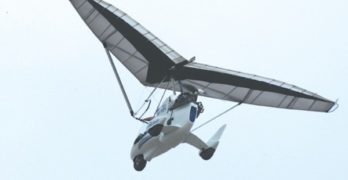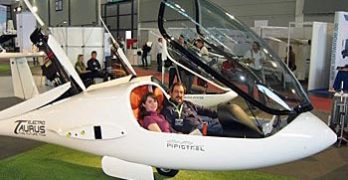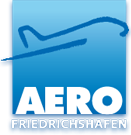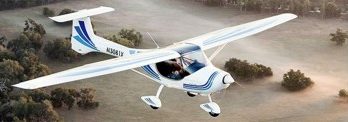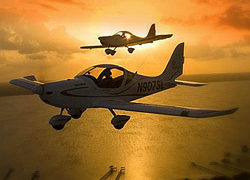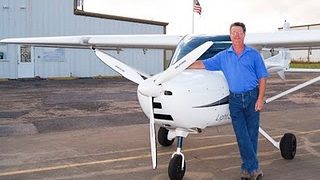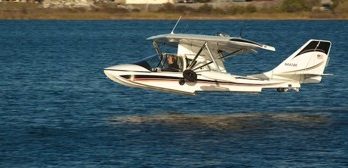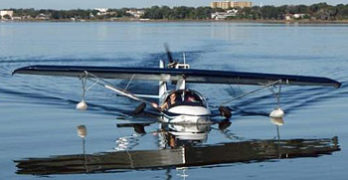Like other start-up success stories, this tale has
a familiar beginning.
“It all started with two guys, Abid Farooqui and
Larry Mednick,” begins the history lesson. The two
started flying trikes a decade ago after discovering
they preferred weight-shift control to conventional
aircraft where each had started.
They didn’t start out as partners.Farooqui wanted
to run a flight school and Mednick, who’d given up
freestyle jet skiing and street bike riding, just wanted
to fly trikes.
Giving instruction hour after hour to a variety of
students, Farooqui began to discover limitations in
the trikes he could buy for his school. Mednick was
finding something similar himself. They loved their
trikes, but they could envision a machine that would
better serve their interests.
Their learning experiences left each of them upside-
down hanging by their seatbelts after a mishap
that slowly but surely shaped the design that was
evolving in their minds.
Search Results for : Flight Design
Not finding exactly what you expected? Try our advanced search option.
Select a manufacturer to go straight to all our content about that manufacturer.
Select an aircraft model to go straight to all our content about that model.
All-American Revo Sets New Standard
Behold the Revo, a new benchmark in weight-shift trike design.
Look carefully and you’ll see the Revo is not like any weightshift
light-sport aircraft you’ve seen before. The Revo had to
surpass impressive work by larger, more established companies to leap
to the forefront. Any way you look at it, the Revo is simply extraordinary.
I’ve been lucky to fly many trikes over the years. Every few years, one
of the leading producers would make a remarkable step forward in the
design of these flying machines with changes that tended to be evolutionary,
not revolutionary. Among them, I cannot recall a clean sheet of
both carriage and wing debuted as a single aircraft.
Welcome to Revo from Evolution Trikes, an all-new, blazingly fast
American trike like none before it.
The more I examined the Revo and then flew with Larry Mednick of
Evolution (and Tampabay Aerosports), I realized even Air Création’s
beautiful Tanarg trike had been done one better.
LEAP Awards Electric Aviation Prizes
Eric Lindbergh, grandson of Charles A. Lindbergh, awarded the LEAP Prize to Pipistrel’s Ivo Boscarol at the just-finished Aero General Aviation convention in Friedrichshafen, Germany. *** The 3rd annual e-Flight gathering took place there also, and Lindbergh’s Best Electric Aircraft award went to Pipistrel’s Taurus Electro. *** There were some notable challengers in the category and three finalists: the Taurus, the Electric Cri-Cri (power by Electravia), and Eric Raymond’s Sunseeker II solar airplane. *** Also awarded was the Best Electric Propulsion. The two finalists were the LZ Design FES (Front Engine Sustainer) system and the Rapid 200 Fuel Cell propulsion system from Polytechnic Torino. *** The LZ FES was the winner. *** The LEAP 2011 Outstanding Achievement Award went to Bertrand Piccard, Andre Borschberg and the Solar Impulse Team for its electric around-the-world project airplane. *** A romantic, and apt, spin on the awards is linking today’s electric pioneers to Lucky Lindy’s amazing transatlantic flight in 1927, which pretty much singlehandedly changed the global perception of aviation from a daredevil hobby or foolhardy mail delivery system to the common transportation, recreational and warfare tool it has become.
Europe’s Aero 2011 in Full Swing
Aero Friedrichshafen, Europe’s big annual GA convention, has more than 600 exhibitors showing their wares and innovations right now through tomorrow. *** Sub-titled The Global Show for General Aviation, if you want to see what’s happening and what’s coming down the pike, you’ll not find a more intensely focused representation than at Aero. *** The show spreads displays from many big names and newcomers alike, up through bizjets, across its 11 big hangar-style display areas. *** I like this show, although lamentably I’ve yet to go, because it never fails to draw cool new stuff, in particular Microlight/LSA developments and electric and solar powered birds. Thousands of visitors flock to the “e-flight Expo” at Aero, in its third year as part of the show. *** Two big events will highlight the show this year: the Berblinger Flight Competition and the awarding of three LEAP prizes from Erik Lindbergh (Lucky Lindy’s grandson).
Aviation Jobs, American Style
Good news from Allegro LSA’s head honcho Doug Hempstead, as he spoke with Plane & Pilot publisher Mike McMann. *** Allegro, now a solely-American made, composite/aluminum SLSA (my flight report is due out soon in the magazine) told Mike he expects to hire as many as 35 workers within the next year. These are jobs that were formerly held by Czech Republic personnel. *** Allegro is a Czech-designed airplane (Fantasy Air) that, like so many LSA, was built in Czech Republic and assembled, test flown and delivered in the States. *** Doug and his wife Betty bought the rights to produce the airplane here and production is now underway at the company’s Sanford, NC plant. *** More than 450 of the Kevlar-composite fuselage/aluminum wing Allegros have been sold since 1994, mostly overseas. The Hempsteads hope to change that proportion…and employ more Americans in the process. *** Three Allegro models are offered: Classic Trainer at $89,000 (also configurable as an IFR trainer), Voyager at $94,000 (adds things like MGL Voyager EFIS, Garmin radio and transponder and vertical card compass), and Executive at $99,000 (adds two Dynon Skyview Synthetic Vision displays).
What Big GA Thinks about Young LSA
I often tell reporters and others that we must all keep in mind that Light-Sport aviation is an industry only six years old, a mere toddler in the realm of general aviation. In that time we’ve seen an astonishing development of all kinds of flying machines, 115 models deep. And this while industry had to write its own certification standards, establish dealer networks, build up supply chains to customers needing parts… from all over the globe, and much more. Contrarily, general aviation is many decades old and most of these systems have been established. *** Those GA folks, with all their experience, offer a way to help LSA grow and mature. LSA producers can learn a lot from these veterans. With that in mind, it may be interesting to hear a few comments from GA leaders. *** In an AIN Online article, writer Matt Thurber begins noting that experts ask the question, “[Is] general aviation (GA)… declining or poised for a renaissance generated by new interest in light sport aircraft (LSA) and avionics technology?” In a thorough response to the inquiry, Thurber cites the following general aviation aircraft production numbers: In 2009 only 1,587 aircraft were shipped, according to GAMA statistics, down from 3,029 in 2008 and a record 3,279 in 2007 (since a high of almost 18,000 aircraft in 1978).
Remos: New Dealer & Boy Scout Pow-Wow
Remos continues to build its U.S. sales/service network. The company just “promoted” Tom Pekar’s Success Aviation, near Houston, from a Pilot Center to it’s 16th Aircraft Dealer in the U.S. *** The new dealer has two Remos GX demos, one with an autopilot. Both are used in the school. *** “Most flight training operations involving the GX use about 3.2 gallons of fuel,” he says, “compared to over 5 in a Cessna 152 and close to 9 in a Skyhawk.” *** With the price of avgas jumping up the way it has been of late, flight schools nationwide have to at least be giving renewed thought to adding LSA trainers to their fleets. *** One of the tangible bonuses the GX brings to its quality build and superb handling characteristics (my personal view: it’s as sweet to fly as any LSA out there) is its capability of flying with the doors off.
Hot Off The Water
To the answer “Progressive Aerodyne!” comes the Jeopardy question, “What LSA company thumbs its nose at the bad economy?” *** Certainly one of the most-fun LSA flights I’ve had in some time came at the controls of that company’s SeaRey amphibian.My LSA pal Dan Johnson recently wrote up a piece on the amphib which spurred me to excerpt some highlights in advance of my own flight report on the lively sea bird coming soon in Plane & Pilot magazine. *** Wayne and Kerry Richter, second and third generation founders of Progressive Aerodyne, started back in the ‘70s with many memorable UL birds they created with dad/grandfather Stanley Richter. The company then was Advanced Aviation and it put out, among other craft, several iterations of a very popular ultralight amphib: the Buccaneer.Building on that success, as Dan notes, Progressive Aerodyne popped out 31 Experimental Amateur Built kits in 2010.
SeaRey Sales Prove Popularity of Amphibians
Progressive Aerodyne and their popular SeaRey amphibian represent a current-day success sufficient to generate envy in most airframe sellers. Consider these results: Searey delivered 31 kits in 2010, an average 2.5 per month during a lousy year. Plus, in just three weeks since Sebring another 14 SeaRey kits have been ordered, upping the monthly average to 4.0. True those SeaReys are Experimental Amateur Built (EAB) kit models and so don’t compare directly with SLSA sales. *** In less than three years, company spokesman and sales director Darrell Lynds (formerly with SportairUSA) took the company from one kit a month to its current pace, along the way building a list of 1,700 very interested potential buyers. He says his 2011 orders are cash-in-hand and projects a solid year for the amphibious seaplane producer. This adds to a remarkably loyal following of 600 SeaRey aircraft builders. How can the central Florida manufacturer be doing so well?
Flying Cessna’s LSA Skycatcher
Honestly, I never thought I’d see this day arrive. As I started work
on a Cessna aircraft review for the pages of Light Sport and
Ultralight Flying magazine, I thought, We’ve come a long way.
When this publication was started 35 years ago, it was titled Glider Rider
and it featured hang gliders. Coverage then expanded to include powered
ultralights, and now light-sport aircraft (LSA) are included in the mix.
This month I’ve written a pilot report on Cessna Aircraft’s Skycatcher
LSA, the first Cessna in modern memory not built to FAR Part 23 standards,
that is, not type-certified by the U.S. government. Some may say ultralights
“grew up” to become light-sports. But I say that Cessna has moved
(returned?) to very light aircraft designs. I consider their arrival significant.
It isn’t simply that you can buy a brand-new Cessna for $112,500 (more on
the price later). The more important point to Light Sport and Ultralight
Flying readers is that the Skycatcher flies similarly to what light aircraft
enthusiasts fly.
- « Previous Page
- 1
- …
- 100
- 101
- 102
- 103
- 104
- …
- 147
- Next Page »


